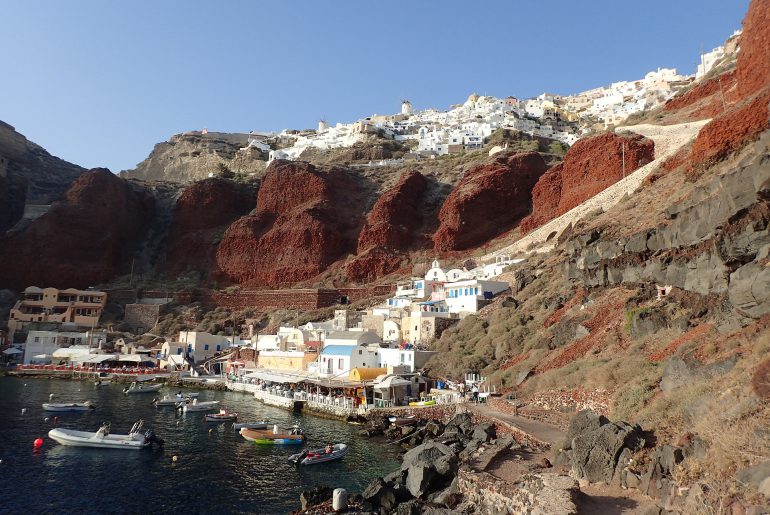Santorini (Thera) today is noted for its sunset panoramas and the unbelievable caldera formed by one of the world’s most devastating events. The magnificent tourist paradise dreamed of by travelers around the world is the end product of a Bronze Age disaster of unequaled scale.
This island’s unique natural beauty and a wild scenery owe their splendor to various volcanic eruptions over the eons of time. And while only the scant remains of the original volcano still stand, islanders live in watchful tranquility, while they overhear ancient rumblings from the still active volcanoes below.
Human history has recorded no more devastating natural event than the eruption of Thera about 1600 BC. The explosion of this ancient volcano destroyed a Minoan settlement at Akrotiri, communities and agricultural areas on nearby islands and inundated the coast of Minoan Crete with related earthquakes and tsunamis hundreds of feet high. These killer waves and the vast ash cloud ejected from the volcano core are what some experts claim factored in the downfall of that great Minoan civilization.

It’s difficult to imagine this catastrophe these days. Santorini is undoubtedly one of the most peaceful places on Earth. But the Plinian eruption the ancient Minoans witnessed was marked by massive columns of volcanic debris and hot gases ejected high into the stratosphere overhead. And the part of the island that disappeared when the caldera collapsed has inspired tales of Atlantis. Legends abound in the Aegean, but none more gripping than the Santorini event itself.
Scientists now believe that the eruption caused significant climatic changes not only in the eastern Mediterranean region and the Aegean Sea but in much of the Northern Hemisphere. There is evidence today that crops in China and other places may have failed on account of the Thera eruption. Tree rings from California to Germany tell the story of a 1628 BC event that could only have been the explosion of Thera. But as immense and unimaginable as this past catastrophe was, the fact the volcano is growing again seems a surreal reality.
Since Minoan Era, the active volcano has gone through several metamorphoses. Post-Minoan eruptive activity has mostly been at the center of the lagoon in the Kameni islands. About 197 BC, the first of these volcanic islands broke the surface of the lagoon. Since then nine more eruptions have taken place, the most recent being back in the 1950s. Most visitors are unaware that Santorini was struck by a devastating earthquake back in 1956. And in 2011 scientists from Georgia Tech in the U.S. found the magma chamber growing once again beneath the volcano. According to a satellite radar technological analyses of the island, this magma chamber was swelled by a rush of molten rock scientists exclaimed was the equivalent to 20 years’ worth of regular activity.
Whatever the future may bring, Santorini will endure, the eternal testament of Greek resolution against the wrath of the Olympians.




